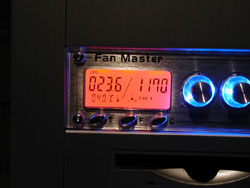|
|
Advertisement:
|
|
Super Flower SF-609 Fan Master |
|
Join the community - in the OCAU Forums!
|
Usage and Conclusions
Usage:
As well as looking good, this is actually quite a useful unit. There's a dramatic difference between the fan noise with the knob turned to the lowest setting or the highest. A multimeter reveals the lowest setting on the dial provides about 7.85v and the highest clockwise setting reported 14.92v. The readings were almost identical on the two headers I checked and increase linearly through the range of motion of the knob. The lowest setting should be enough to start virtually all fans - even the monster aluminium-bodied 120mm Panaflo lumbered into life without complaint when the PC was turned on with the fan-speed knob at the lowest setting. The maximum setting of nearly 15v is 3v higher than most PC fans are expecting, usually running off the 12v line like most electric motors in a PC. I'd expect most fans to cope fine with that, even running long-term. But if you bought a fan controller to run your fans at full noise all the time that'd be a bit silly anyway.

The T button allows you to cycle through the four temperatures being monitored, while the F button does the same for fan speeds and the C button cycles through the colours of the LCD backlight. Note that, unlike the DigiDoc, the temperatures and fan speeds are not in any way linked. You can display fan speed 3 while also displaying temperature readout 1, for example, and only use as many temperature or fan connectors as you need. You can also change the display between Celcius and Fahrenheit reporting.
As you cycle through the temperatures, the presets of CPU, HDD, CASE and POWER are highlighted on the LCD. As mentioned earlier there's nothing stopping you from monitoring whatever you like instead of the suggested presets. The writing is quite small and near the top of the display, so it's fairly hard to see anyway unless you are looking at the screen from directly ahead.
There's an alarm for temperature - you set whatever temperature threshhold concerns you for a given sensor and if it's exceeded the unit will beep for 20 seconds and flash the temperature readout until the temperature drops. I tested this by setting the threshhold for a sensor taped to the top of my HDD to 25C. After a few minutes the temperature passed this mark and the unit started beeping loudly. It will also beep if a fan drops below 600rpm, and flash the appropriate readout. My highly scientific test of turning the fan speed down to the lowest setting and then jamming an allen key between the blades produced the results you'd expect - much beeping and flashing, until the fan was allowed to spin again. Inside the Fan Master is a small peizo speaker very similar to the ones seen on motherboards. It's loud enough to be heard in the next room, but it would be better to have it continue beeping until you press a button. Otherwise, it beeps for 20 seconds and then stops, so if you are away from the PC during the beeping and then return, the system relies on you noticing the flashing display (not particularly eye-catching) to alert you to the problem.
One of the fans I used for testing didn't support RPM monitoring - only 2 pins of the 3-pin header are populated. The Fan Master didn't panic, simply reporting 0 RPM. I suppose a short period of RPM reporting is required before it will consider "below 600 RPM" to be a fault. The situation is the same when using a molex-powered fan and a 3-pin adapter. The 600 RPM limit is not configurable, but even on the lowest power setting none of the fans I tested dropped below 1000 RPM.
The electronics of fan controllers can sometimes run very hot. After running a few fans at various settings for 20 minutes the unit was barely warm, even the transistors for each fan circuit, so no concerns there. The unit is also silent while operating, as you'd expect.
Conclusions
Overall, this is quite a neat little gadget. To complete the "custom" feature, it would be better if you could change the colour of the LEDs illuminating the fan-speed knobs - or even turn them off completely. The instructions could use a little clarifying here and there and I'd prefer the alarm to sound until it is manually turned off. All up though, this unit works very well and is a pretty attractive implementation of a basic fanbus with temperature and fan monitoring. The ability to change the unit's appearance is a nice touch too. If you're after a fan controller with temperature and RPM monitoring, definitely consider the Fan Master!
Thanks to Super Flower in Taiwan for providing the review unit. I don't think it's available in Australia yet, but I know they have approached at least one local company to carry their products. Stay tuned!
Update: David & Karma will apparently have this unit for $59 soon.
|
|
Advertisement:
All original content copyright James Rolfe.
All rights reserved. No reproduction allowed without written permission.
Interested in advertising on OCAU? Contact us for info.
|

|


